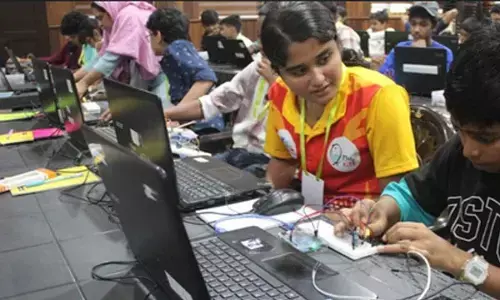A new era of economic renaissance in India

With a forecasted 7% GDP growth rate, India stands at the forefront of economic innovation
In a packed auditorium at the Kautilya Economic Conclave, Jagdish Bhagwati, the renowned Indian-American economist, spoke with a confidence that matched the scale of India's transformation. His words echoed with a sense of pride and progress: "India’s economic situation has undergone a complete transformation. In the old days, the World Bank used to tell India what to do, but now, India tells the World Bank what to do. We have completely arrived at a new age." His statement perfectly encapsulated India’s extraordinary journey—from an economy that once followed external guidance to one that now shapes global economic discourse.
The World Bank’s recentIndia Development Update (IDU) underscored this economic transformation, projecting a robust 7% GDP growth rate for FY 2024-25, with similarly positive forecasts for the future. It also noted that India remains the fastest-growing major economy, with growth accelerating from 7.0% in FY 2022-23 to 8.2% year-on-year in FY 2023-24. Furthermore, the International Monetary Fund (IMF) World Economic Outlook (WEO) Database reported that India’s GDP ranking improved significantly, moving from the 10th largest economy in 2013-14 to the 5th largest in 2021-22.
In addition to this economic progress, NITI Aayog’s report titled 'Multidimensional Poverty in India since 2005-06' revealed that 24.82 crore people have escaped multidimensional poverty between 2013-14 and 2022-23. This significant reduction is attributed to various government initiatives aimed at addressing all dimensions of poverty during this period. The report emphasizes that these efforts have played a crucial role in improving the well-being of millions across the country. Furthermore, Provisional Estimates released by the National Statistical Office indicate that India’s per capita GDP at current market prices for 2023-24 stands at ₹2,11,725, underscoring the nation’s economic advancement.
This positive outlook results from deliberate reforms and visionary leadership over the past decade. A key factor in India’s economic turnaround was the introduction of the Goods and Services Tax (GST) in 2017, which unified the country into a single market by simplifying fragmented state-level taxes. As a result, GST collections soared to ₹20.18 lakh crore in 2023-24, averaging ₹1.68 lakh crore monthly.
As India strengthens its economic foundation, financial inclusion has emerged as a crucial driver of equitable growth. The Pradhan Mantri Jan Dhan Yojana (PMJDY), launched a decade ago, has transformed access to the banking system, with over 53 crore accounts opened by October 2024. This initiative has brought millions of previously unbanked individuals into the formal financial fold, enhancing access to services and reducing economic inequality. Along with GST, these reforms have significantly fuelled India’s ongoing transformation toward inclusive growth.
The “Make in India” initiative, introduced in 2014, has also been pivotal in positioning India as a global manufacturing hub. By simplifying regulations and improving the ease of doing business, the initiative has attracted record-breaking levels of Foreign Direct Investment (FDI). Between April 2014 and March 2024, India secured $667.41 billion in FDI, with an impressive $84.83 billion coming in the 2021-22 fiscal year alone. This influx of investment has fuelled industrial growth, created jobs, and strengthened India’s role in global supply chains. India’s growing appeal as a manufacturing hub is also bolstered by its vast market and entrepreneurial spirit.
Alvaro Santos Pereira, Chief Economist at the Organisation for Economic Co-operation and Development (OECD), echoed this sentiment in a recent interview, saying, “India has all it takes to have a strong rate of growth over the next few decades. There have been significant reforms in the past 10 years, and there’s a dynamism, an entrepreneurial spirit, and a reformist attitude I don’t see in many countries.” Pereira’s words emphasize the unique blend of ambition, resilience, and foresight that is driving India’s economic resurgence.
Infrastructure has been another critical pillar of India’s growth story. Flagship projects like Bharatmala Pariyojana and PM Gati Shakti have transformed the country’s transportation and logistics sectors. In the last 5 years, more than 24,000 kilometers of highways have been constructed, reducing travel time and improving connectivity between economic hubs. These projects are also key contributors to employment, creating millions of jobs across the country. By investing in infrastructure, India is not only improving its domestic mobility but also setting the stage for continued economic expansion.
Innovation is another area where India’s transformation is clearly visible. The Atal Innovation Mission (AIM), launched in 2016, has nurtured young talent by establishing over 10,000 Atal Tinkering Labs in schools. These labs encourage students to explore new technologies and develop problem-solving skills, laying the groundwork for future breakthroughs. This focus on innovation has contributed to the rapid expansion of India’s startup ecosystem, now the third largest in the world. As of October 2024, India boasts over 150,000 recognized startups, which have created more than 1.5 million jobs, highlighting the country’s entrepreneurial vitality.
As Jagdish Bhagwati remarked, "We have completely arrived at a new age," reflecting India's growing prominence on the global stage. In 2023, India assumed the G20 presidency, a significant milestone in its international journey. Under the theme "Vasudhaiva Kutumbakam" (the world is one family), India hosted the 18th G20 Leaders' Summit in New Delhi. During the "One Family" session, Prime Minister Narendra Modi announced the adoption of the New Delhi Leaders' Declaration, a landmark achievement amid rising geopolitical tensions, including the Ukraine conflict. This presidency showcased India’s diplomatic leadership and reaffirmed its commitment to multilateralism at a time of deepening divisions among major powers.
India has also taken a leading role in promoting sustainable development through initiatives like the International Solar Alliance (ISA), launched in 2015 with France to mobilize $1,000 billion in solar energy investments by 2030. The seventh session of the ISA Assembly will take place in November in New Delhi, further emphasizing India's leadership in global sustainability efforts. This commitment to renewable energy is underscored by the achievement of 1.02 million jobs in the renewable energy sector in 2023, as reported by the 2024 Annual Review of the International Renewable Energy Agency (IRENA). As of October 10, 2024, India's renewable energy capacity surpassed 200 GW, reaching 201.45 GW, reflecting substantial progress toward a greener future and sustainable economic growth.
India’s transformation, from an economy that once took advice from global institutions to one that now shapes international economic strategies, is a remarkable testament to its resilience and ambition. With sustained reforms, robust infrastructure development, and an entrepreneurial spirit, the country is poised for long-term growth. India’s combination of reformist zeal and a dynamic economy sets it apart, ensuring that its transformation will continue to influence global economic discourse for years to come. (PIB)
















